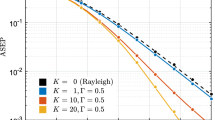Abstract
Fast frequency hopping can reduce the degradation caused by interference. The performance of noise-normalized fast frequency-hopped M-ary orthogonal frequency-shift-keying (FFH/MFSK) receivers over frequency nonselective Rayleigh fading channels with partial-band noise jamming is analyzed. Instead of numerical evaluation, a closed-form error probability expression is given based on the theory of complex variables. The simulation results validate the analytical results. It is shown that there is an optimum diversity order and the system performance gets better with an increase in the modulation order.
Similar content being viewed by others
References
Han Y, Teh K C. Performance study of suboptimum maximum likelihood receivers for FFH/MFSK systems with multitone jamming over fading channels. IEEE Trans Veh Tech, 2005, 54: 82–90
Keeler C M, Pursley M B. Clipper diversity combining for channels with partial-band interference-Part II: Ratio-statistic combining. IEEE Trans Commun, 1989, 37: 145–151
Teh K C, Kot A C, Li K H. Partial-band jamming rejection of FFH/BFSK with product combining receiver over a Rayleigh-fading channel. IEEE Commun Lett, 1997, 11: 64–66
Robertson R C, Lee K Y. Performance of fast frequency-hopped MFSK receivers with linear and self-normalization combining in a Rician fading channel with partial-band interference. IEEE J Select Areas Commun, 1992, 10: 731–741
Lee J S, Miller L E, Kim Y K. Probability of error analyses of a BFSK frequency-hopping system with diversity under partial-band jamming interference — part II: performance of square-law nonlinear combining soft decision receivers. IEEE Trans Commun, 1984, 32: 1243–1250
Li G, Wang Q, Bhargava V K, et al. Maximum-likelihood diversity combining in partial-band noise. IEEE Trans Commun, 1998, 12: 1569–1574
Maljevic I Z, Dukic M I. Comparison of FFH FSK nonlinear combining receivers in a fading channel with partial-band interference. In: Spread Spectrum Techniques and Applications Proceedings. In: IEEE 4th International Symposium on Spread Spectrum Techniques and Applications Proceedings. Mainz: IEEE, 1996. 1273–1277
Proakis J G. Digital Communications. 4th ed. New York: McGraw-Hill, 2001. 512–516
Aalo V, Ugweje O, Sudhakar R. Performance analysis of a DS CDMA system with noncoherent M-ary orthogonal modulation in Nakagami fading. IEEE Trans Veh Tech, 1998, 47: 20–29
Author information
Authors and Affiliations
Corresponding author
Rights and permissions
About this article
Cite this article
Zhou, Z., Li, S. & Cheng, Y. Performance analysis of a noise-normalized FFH/MFSK receiver over Rayleigh fading channels with partial-band noise jamming. Sci. China Inf. Sci. 54, 129–135 (2011). https://doi.org/10.1007/s11432-010-4081-y
Received:
Accepted:
Published:
Issue Date:
DOI: https://doi.org/10.1007/s11432-010-4081-y




